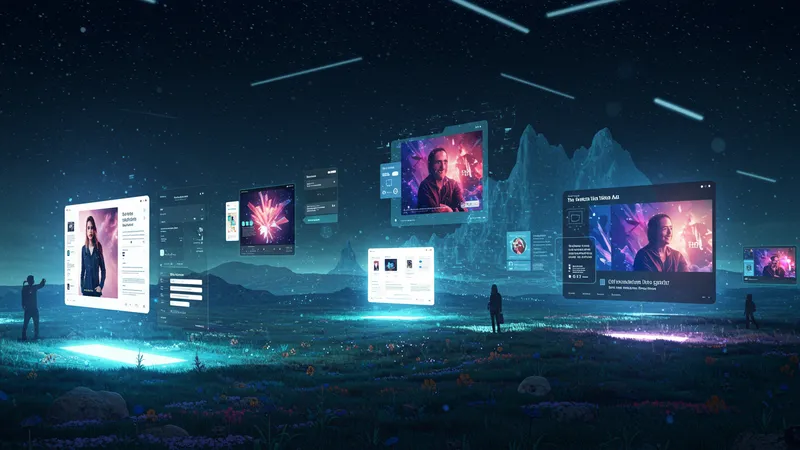

Native video ads blend seamlessly into a user's browsing experience, appearing as natural content rather than disruptive commercials. Unlike traditional ads which interrupt with abrupt visuals or sound, native video ads match the look, feel, and function of the platform they appear on—be it social media feeds, news articles, or mobile apps. This integration ensures viewers remain engaged, finding the ad content informational or entertaining instead of intrusive.
At their core, native video ads are designed to align with user expectations based on where they are seen. They use format, tone, and storytelling that mirror organic content, so viewers are more likely to watch, interact, and remember the message. The strategy behind these ads is to enhance engagement, driving higher completion rates and fostering positive brand associations without interrupting the user's experience.

The leading benefit of native video ads is their non-disruptive nature. When viewers feel content is naturally part of their feed, they are less likely to skip or ignore it. Studies suggest completion rates for native video ads can be up to twice as high as those for pre-roll or banner video placements.
Platforms like Taboola and Outbrain empower advertisers and publishers to scale this approach by using advanced algorithms that select relevant placements. These services ensure ads are targeted contextually, meaning ads appear only where they might interest or help the viewer, increasing the likelihood of engagement.
Facebook’s in-feed video ads exemplify how seamless integration can maximize engagement. By placing video ads among users’ personal photos, posts, and updates, advertisers reach audiences inside the social context they trust. This increases the chances for meaningful interaction—likes, shares, and comments—compared to interruptive ads that stand apart as clearly sponsored.
When evaluating effectiveness, many marketers find that native video far outperforms traditional display or pop-up ads. Higher viewability scores translate to more memorable campaigns and better outcomes for brand awareness or product consideration. The power of context and seamless integration cannot be underestimated in today’s digital advertising landscape.
In summary, native video ads represent a dramatic shift in digital marketing—one that favors audience respect and user experience. As we explore deeper, the subtleties of placement, targeting strategies, and creative execution reveal even more ways brands are achieving outstanding engagement with native video advertising. The deeper details reveal even more valuable insights ahead…
Placement is crucial when it comes to native video ads. Unlike traditional ad slots that disrupt content, native video ads are inserted where viewers naturally spend their attention—such as news feeds, between articles, or embedded in stories. This strategic positioning enhances the likelihood that users will watch the video without perceiving it as an interruption. Effective placement depends on matching the ad’s format to the content structure of the surrounding platform.

Context amplifies the effectiveness of these ads. For example, Taboola uses sophisticated algorithms to determine the most relevant articles and publishers for each ad, ensuring the video resonates with the viewer’s current interests. Outbrain similarly harnesses contextual targeting to increase ad relevance, thus raising the probability of user engagement. The power of such contextual alignment sets native video ads apart from more rigid digital placements.
Facebook’s in-feed video ads showcase context at scale. By placing videos amid personal social content, the platform increases the sense of trust and reduces skepticism. These ads can also be targeted based on interests, behaviors, and demographics, ensuring the message is tailored to each audience segment. This thoughtful approach encourages users to watch and even share the videos, driving organic reach and secondary engagement beyond the initial impression.
Optimal placement and context aren’t achieved by guesswork. Marketers rely on audience analytics and performance data to fine-tune where and how native video ads appear. Continuous data-driven optimization is vital to ensure ads remain relevant, engaging, and invisible as interruptions. As we move forward, understanding the creative strategies behind crafting these ads can offer further advantages to brands seeking meaningful connections.
Storytelling remains at the heart of successful native video ads. Effective campaigns avoid overtly sales-driven messages and instead focus on genuine narratives that resonate emotionally. Brands leveraging Taboola and Outbrain often craft mini-documentaries, customer testimonials, or problem-solution scenarios that match the tone of the publisher’s content, enhancing both authenticity and relatability.

Visual consistency boosts engagement. Native video ads that mirror the style and quality of surrounding content perform better, as users do not immediately distinguish them from editorial videos. Facebook’s business tools allow advertisers to preview their ads alongside user-generated posts, enabling designers to maintain a cohesive visual identity that feels like a natural part of the user experience.
Length and pacing are also critical. Data shows that shorter videos—typically under 30 seconds—achieve higher completion rates in social feeds and publisher placements. Native ad platforms often recommend concise, focused storytelling, starting with a compelling hook in the first few seconds to capture attention before viewers scroll onward. Quick, visually engaging motion and captions aid in holding interest, especially as many users watch videos on mute.
Interactivity is gaining ground in native video ads. Some platforms now support subtle interactive features, such as polls, swipe actions, or clickable overlays, encouraging users to engage without leaving their current environment. These enhancements sustain momentum and provide valuable feedback to advertisers, who can then refine their creative strategies for even greater relevance and performance.
Tracking the impact of native video ads requires sophisticated analytics tailored to in-feed and contextual placements. Metrics like viewability, average watch time, completion rates, and engagement actions (such as clicks, likes, or shares) provide a holistic view of an ad’s effectiveness. Platforms like Taboola and Outbrain offer advertisers real-time dashboards to monitor these indicators, facilitating agile adjustments to campaigns.

Facebook’s ad manager provides granular breakdowns of audience demographics, device usage, and even post-view interactions. Advertisers can analyze which segments are engaging most with their video content and adjust targeting or creative messaging accordingly. This feedback loop allows for continuous improvement and ensures that campaigns keep pace with shifting audience behaviors.
Incremental lift studies are becoming more common. Brands can isolate the specific contribution of native video ads to awareness or consideration by comparing exposed and unexposed groups. This scientific approach to measurement makes it easier to justify native ad spend and to fine-tune creative assets for better results in future campaigns.
Return on investment is typically higher for native video ads thanks to their elevated engagement metrics and lower skip rates compared to interruptive formats. Marketers leveraging robust analytics can pinpoint which placements, formats, or narratives yield the strongest outcomes, ensuring that each ad dollar delivers maximum impact. As competition for audience attention intensifies, these measurement strategies are key to maintaining a dynamic advertising presence.
The future of native video ads is intertwined with advances in artificial intelligence and personalization. Automated tools are expected to further refine ad placement and messaging by predicting which types of content resonate best with individual viewers. This level of customization will make advertisements even more seamless, reducing ad fatigue and deepening brand-consumer relationships.

Emerging formats, like shoppable videos or augmented reality overlays, are expanding what’s possible in native advertising. These innovations allow users to engage with products without leaving their current environment, transforming video ads from passive viewing experiences to interactive discovery moments. The move toward these immersive formats is poised to enhance user engagement and drive higher conversion rates without compromising user experience.
Stricter privacy standards and changes to third-party tracking are also shaping the evolution of native video ads. Marketers are investing in contextual data and first-party insights to maintain effective targeting as cookies and traditional tracking decline. Native platforms that prioritize transparency and user control are positioned to build greater trust and resilience in the evolving advertising ecosystem.
Ultimately, the seamless integration of native video ads is expected to become the standard in digital marketing. As technology advances and audience expectations shift toward less disruptive experiences, brands that adopt and adapt to these methods will be best equipped to drive ongoing engagement. Staying ahead with innovative, user-centric strategies will ensure long-term relevance in the ever-changing landscape of digital advertising.